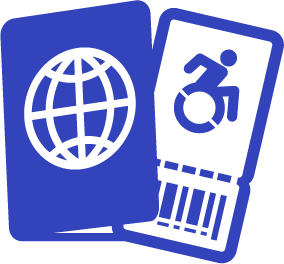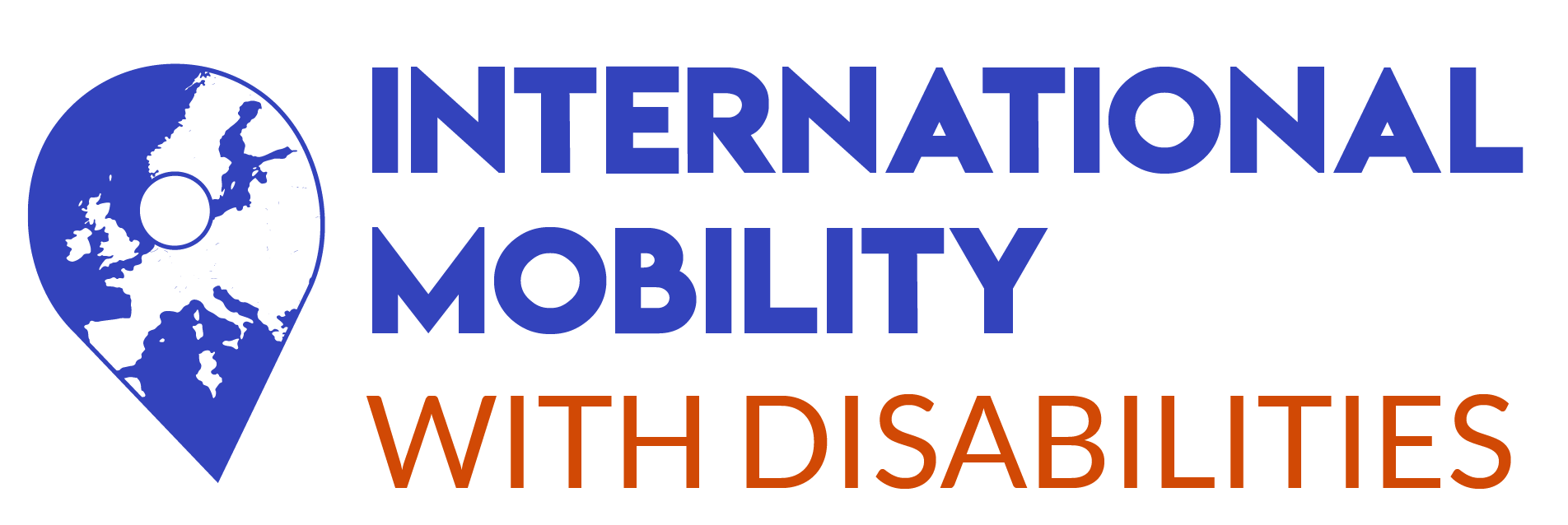
FOR YOUTH WORKERS & ORGANIZATION

Disability and international mobility, it is possible.
This section aims to provide an overall definition of disability, and describes the various measures implemented by the European Union in order to enable young people with disabilities to engage in international mobility.
1. What is disability ?
According to the World Health Organisation, a person with a disability is “limited in activity or restricted in participation in society by a substantial, permanent or permanent impairment of one or more physical, sensory, mental, cognitive or psychological functions, a multiple impairment or a disabling health condition”. However, the definitions and recognition of disability varies depending on the country and culture.
The United Nations Convention on the Rights of Persons with Disabilities (UNCRPD), adopted in 2006 by the UN, is an international instrument that sets minimum standards for the rights of persons with disabilities. It “promotes, protects and ensures” the equality, human rights and fundamental freedoms of all persons with disabilities. It ensures the right to autonomy, self-esteem, integrity, education and learning of persons with disabilities and recalls the condemnation of discrimination and abuse against them. It has been signed and ratified by all EU Member States. EU countries are therefore obliged to respect this convention, but each country also has its own legislation.
According to the World Health Organisation, there are almost one billion people with disabilities living around the world. The majority of them struggle to take their place in our societies and are deprived of certain opportunities. Associations and foundations – most of them composed of representatives of this population as active members, project promoters or participants in innovative initiatives and contributions – are working to fight against these discriminations. However, these actions, even if indispensable, are mainly deployed in the limited field of adaptation of places.
2. Disability recognition in Europe
It took a long time for the European Union to get involved in making disability policies. Efforts started in the late 80s and resulted firstly to the Helios programme and the creation of the European Disability Forum in 1997(Council of Europe). With the Treaty of Amsterdam (1999), the right of non discrimination is established and serves as a basis for people with disabilities thank to the article 13 and the EU Directive on Equal Treatment in Employment and Occupation. This policy has been reinforced by the EU Charter on Fundamental Rights in its article 21 prohibiting any discrimination based on any ground, including disability. Moreover, its article 26 recognizes the right of people with disabilities to be independent, included and the right to participate in the affairs of every community. In 2010, the Commission adopted the European Disability Strategy (2010-2020) and ratified in 2011 the UNCRPD.
At the European level, the numbers of people with disabilities vary between sources because they do not have the same definition of disability and do not use the same methodology to survey the population. Between 43 millions (according to Eurostat) and 80 millions (according to the Council of Europe) Europeans have a disability or an impairment but it is difficult to extract proportion on young people with disabilities. Indeed, statistics about this part of the population are difficult to find because young people are a less visible group as well as people with disabilities (Council of Europe). Moreover, the understanding of disabilities varies from a country to another. Besides, the European Disability Strategy leaves to member states the choice regarding the definition of disability.
We will remember that not all countries have the same conception and sometimes not the same legislative definition of disability. It varies according to the culture but also to the political and representative system in place in the country, some countries have national laws that allow the proliferation of inclusive initiatives, others operate more through regional or local regulations.
Sweden is a very good example regarding the inclusion of people with disabilities, both in its legislation and in the organisation of its transportation, labour market and accessibility. This is reflected through the definition of disability in Swedish legislation. According to this concept, a disability occurs when a person encounters an environment that is inaccessible. Thus, for the Swedes, a disability does not refer to a person’s inherent abilities but rather to the relationship between a person and his or her environment.
3. How does Europe support the mobility of young people with disabilities?
Regarding the mobility of people with disabilities, they represent less than 0.5% of the mobilities each year. The internationalisation of European students continues but there are still many obstacles for people with disabilities.
This is why Erasmus+ is committed to supporting people with disabilities with additional financial aid to complement existing aid (e.g. grants based on social criteria). According to the E+ Agency, this support “allows to cover additional costs directly concerning participants with disabilities and the persons accompanying them. The programme also provides additional funding to enable the participants concerned to have access to adapted technical and pedagogical support. However, in 2020 only 0.11% to 0.15% of students and trainees will benefit from this special support. Further information is available on the EPFIME project website, however, this website relates to student mobilities only.
European universities often have specialised disability departments, the European Agency for Inclusive and Adapted Education has listed these services on its website. For each country there is a list of key contacts, a description of the inclusive education system in place in the country, resources, figures and project examples. There is also a section to keep up to date with the latest information on the issue within the country.
Before choosing a country of destination for mobility, a young person with a disability can therefore find out about the different provisions in place and make his or her choice with confidence. Finally, the interactive website MappED developped by the Erasmus Student Network allows you to check the accessibility of higher education establishments and provides a certain amount of practical information. The choice of country is also based on the accessibility of the city, which is why the European Commission has launched the Access City Award for cities that provide better access to transport and public places for people with reduced mobility.
We would also like to add that the new Erasmus+ 2020-2021 programme makes inclusion its priority, and in this sense, access to international mobility will be strengthened for young people with fewer opportunities, as is the case for young people with disabilities. (For more information : The new programme 2021-2027)
However, young people with disabilities also need support and resources to develop their project in the best possible way. Consult the other pages of the website to know more about the support of the young person, before departure and during the mobility.

